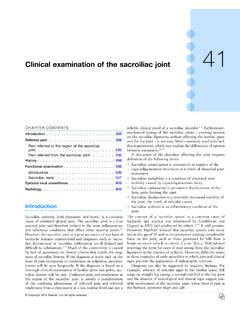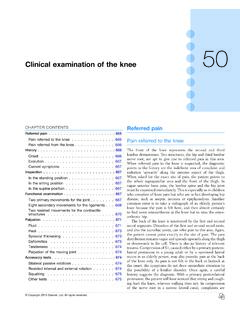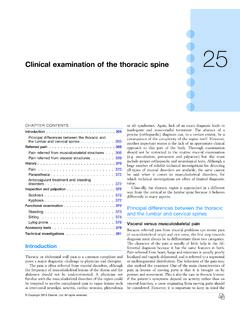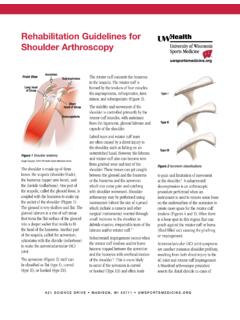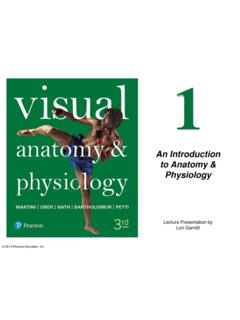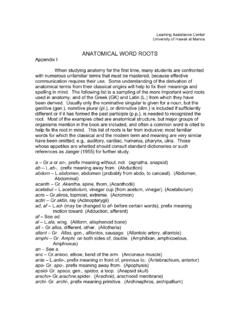Transcription of Applied anatomy of the shoulder
1 Applied anatomy of the shoulder CHAPTER CONTENTS Rotator cuff .. e49. Introduction .. e39 Nerves and blood vessels .. e49. Bones .. e40 Suprascapular nerve .. e49. Scapula .. e40 Axillary nerve .. e49. Humerus .. e41 Subclavian artery and vein .. e50. Clavicle .. e41. Joints and intracapsular ligaments .. e41. Introduction Glenohumeral joint .. e41. Subacromial space .. e42 The main function of the joints of the shoulder girdle (Fig. 1). Acromioclavicular joint .. e42 is to move the arm and hand into almost any position in rela- Sternoclavicular joint .. e42 tion to the body. As a consequence the shoulder joint is highly Scapulothoracic gliding mechanism.
2 E43 mobile, where stability takes second place to mobility, as is evident from the shape of the osseous structures: a large Extracapsular ligaments .. e43. humeral head lying on an almost flat scapular surface. Stability Coracoacromial ligament .. e43 is provided mainly by ligaments, tendons and muscles; the Coracoclavicular ligaments .. e43 bones and capsule are of secondary importance. Costocoracoid fascia .. e43 The function of the shoulder girdle requires an optimal and Bursae .. e44 integrated motion of several joints. In fact five joints' of impor- tance to shoulder ' function can be distinguished:1. Subacromial subdeltoid bursa .. e44. The glenohumeral joint (1).
3 Subcoracoid bursa .. e44. The acromioclavicular joint (2). shoulder movements .. e44 The sternoclavicular joint (3). Muscles and tendons .. e45 The subacromial joint or subacromial gliding mechanism Adduction .. e45 (4): the space between the coracoacromial roof and the humeral head, including both tubercles. This is the Abduction .. e46. location of the deep portion of the subdeltoid bursa Medial rotation .. e47. The scapulothoracic gliding mechanism (5): this functional Lateral rotation .. e47 joint is formed by the anterior aspect of the scapula Flexion of the elbow .. e48 gliding on the posterior thoracic wall. Extension of the elbow .. e48 Optimal mobility also requires an intact neurological and mus- Flexion.
4 E48 cular system. Copyright 2013 Elsevier, Ltd. All rights reserved. The shoulder 2 6 1. 4 3. 1. 2. 5. 3. 5. 4. Fig 1 A global view of all five joints of the shoulder girdle: 1, glenohumeral joint ; 2, acromioclavicular joint ; 3, sternoclavicular joint ; 4, subacromial joint or subacromial gliding mechanism;. 5, scapulothoracic gliding mechanism. Fig 2 Posterior view of the scapula: 1, coracoid process; 2, It is not our intention to give a complete anatomical review, acromion; 3, glenoid; 4, infraspinal fossa; 5, scapular spine; 6, supraspinal fossa. which can be obtained from anatomy texts. Only those structures which are of specific clinical importance will be focused on.
5 1 2. Bones Osseous structures of interest are the scapula, humerus and clavicle. Neither the vertebral column nor the thoracic cage is discussed here (see chapters on the anatomy of the cervical and thoracic spine). Scapula 3. The scapula is a thin sheet of bone that functions mainly as a site of muscle attachment (Figs 2 3, see Putz, Figs. 286, 287, 288). Its medial border is parallel to the spine, the lateral and superior borders are oblique. It has a superior, a lateral and an inferior angle. The inferior angle corresponds to the interspinal 4. level between the spinous processes of T7 and T8. The scapula contains four processes: the acromion, the cora- coid, the spine and the articular process (the glenoid).
6 The dorsum of the scapula is convex. It is divided by its spine into two fossae: the supraspinal and infraspinal fossa, containing the corresponding muscles. The scapular spine runs Fig 3 Anterior view of the scapula: 1, acromion; 2, coracoid from the junction of the upper and middle third of the medial process; 3, glenoid fossa; 4, anterior surface. border, where it is rather flat, and corresponds to the level of the third thoracic spinous process. Laterally it becomes more anterior aspect of the scapula, is a large concavity which con- prominent and meets the acromion at a right angle posteriorly. tains the subscapularis muscle. This angle is easily palpable and is one of the main bony land- At the lateral angle, just beyond the neck of the scapula, marks at the shoulder .
7 The acromion turns further anteriorly is the glenoid fossa. This has a rather shallow surface, which and covers part of the humeral head. is directed anterolaterally and slightly cranially tilted. It is The coracoid process is found at the anterior aspect of the approximately one-quarter the size of the humeral head and scapula. The tip points outwards and is easily palpated in this, plus its shallow concavity, makes the joint both very the lateral part of the subclavian fossa. Further down, on the mobile and vulnerable to (sub)luxations. Copyright 2013 Elsevier, Ltd. All rights reserved. e40. Applied anatomy of the shoulder 2 1. 1. 4. 3. 2 3. Fig 5 shoulder (glenohumeral) joint : 1, labrum; 2, glenoid cartilage; 3, shoulder capsule.
8 Fig 4 Superior view of humerus: 1, humeral head; 2, minor tuberosity; 3, major tuberosity; 4, bicipital sulcus. geometrical relationship between glenoid and head which is responsible for the considerable mobility of the joint but is also an important predisposing factor to glenohumeral instability. The ventral surface of the scapula is flat and covered with First, the large spherical head of the humerus articulates against the attachment of the subscapularis muscle, except for the the small shallow glenoid fossa of the scapula (only 25 30%. medial border and inferior angle where the serratus anterior of the humeral head is covered by the glenoid surface).
9 Second, muscle is inserted. the bony surfaces of the joint are largely incongruent (flat glenoid and round humerus). However, the congruence is Humerus greatly restored by the difference in cartilage thickness: glenoid cartilage is found to be the thickest at the periphery and thin- The articular surface of the humeral head points in a medial, nest centrally, whereas humeral articular cartilage is thickest posterior and slightly caudal direction and is separated from centrally and thinnest peripherally. This leads to a uniform the major and minor tuberosities by its anatomical neck. contact between humeral head and glenoid surface throughout When the arm is hanging down the side with its anterior shoulder motion.
10 Aspect facing the body, the greater tuberosity lies laterally and The labrum is a fibrous structure that forms a ring around the lesser tuberosity anteriorly. They are separated from each the periphery of the glenoid (see Putz, Fig. 298). It acts as an other by the bicipital sulcus (Fig. 4). anchor point for the capsuloligamentous structures and for the long head of the biceps. It further contributes to stability of the joint by increasing the depth of the glenoid socket, enlarg- Clavicle ing the surface area and acting as a load-bearing structure for the humeral head. The clavicle joins the sternum to the acromion. At its medial The synovial membrane of the joint capsule is mainly end it has a forward convexity whereas its lateral end is rather attached to the labrum, covering its inner surface, and at the more concave (see Putz, Fig.)


